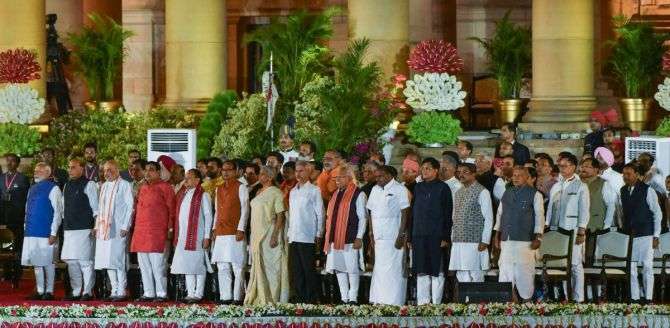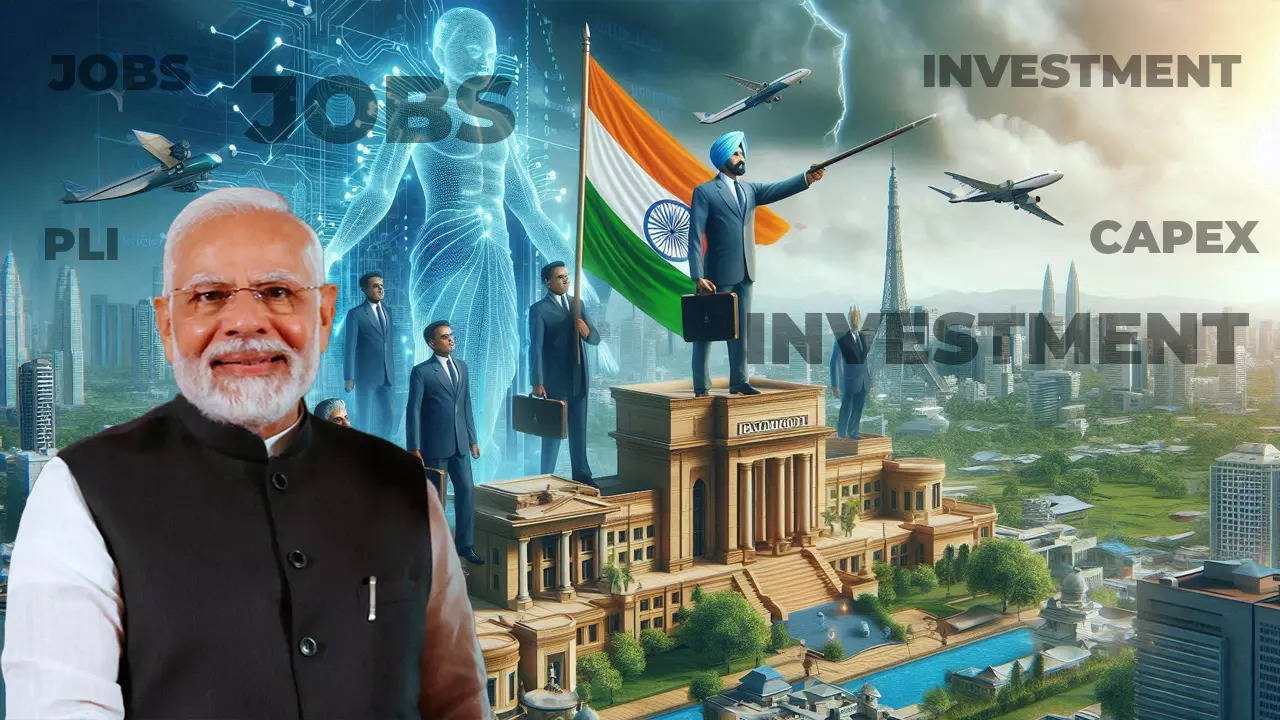No Change, Modi Retains His Old Team, All Eyes On FM Nirmala Sitharaman’s Budget; Without A Full Majority, Supported By Key Allies, Will Modi 3.0 Stay The Course?

Will the Narendra Modi government, which has come back to power for the third time but without a full majority and supported by key allies, stay the course, or will the allies force it to change the course?
Well, for now, it seems that Prime Minister Narendra Modi has largely reposed faith in the team from his previous administration, retaining the same Big Four cabinet members who comprise the Cabinet Committee on Security (CCS) as portfolios were announced on Monday evening.
Most senior ministers from the last term have been entrusted with the same responsibilities, while new faces and allies have been included in departments vacated by those who lost the elections or were relocated to their home states.
Thus, leaving no doubt that the Prime Minister’s main target is the completion of projects initiated by the previous government as part of a roadmap for the next 25 years. To this end, he has broadly chosen the same leaders who have been instrumental in driving this strategy.
Amit Shah retains the home portfolio, Rajnath Singh remains the defense minister, Nirmala Sitharaman continues as finance minister, and S Jaishankar keeps his position as external affairs minister, dispelling speculation that the CCS might see new members.
Going forward, no significant disruptions are likely.
The portfolio allocations reflect PM Modi’s confidence in his key ministers who have retained their positions. This suggests that policy continuity will be a hallmark of the Modi 3.0 administration.
Despite expectations that the BJP’s allies would demand significant ministries, potentially hindering Modi’s economic growth agenda, the portfolio allocation indicates no substantial change in the direction of Modi’s economic policies.
 His core team of ministers has also retained their portfolios. Nitin Gadkari will continue overseeing road transport and highways, Piyush Goyal remains in charge of commerce and industry, and Dharmendra Pradhan continues with education.
His core team of ministers has also retained their portfolios. Nitin Gadkari will continue overseeing road transport and highways, Piyush Goyal remains in charge of commerce and industry, and Dharmendra Pradhan continues with education.
Sarbananda Sonowal retains the ports, shipping, and waterways portfolio, Virendra Kumar stays with social justice and empowerment, and Ashwini Vaishnaw continues to handle railways, electronics, and information technology.
Hardeep Puri remains responsible for petroleum and natural gas, and Bhupender Yadav will keep managing environment, forest, and climate change.
Some ministers have shed additional portfolios that were assigned when others exited the council of ministers in the past. Additionally, Vaishnaw now has charge of the information and broadcasting ministry, previously headed by Anurag Thakur.
The BJP has also made efforts to accommodate its NDA allies.
Former Karnataka chief minister and JDS leader HD Kumaraswamy has been assigned the heavy industries and steel ministries, a tradition for allies in previous UPA and NDA governments.
HAM-S president and former Bihar chief minister Jitan Ram Manjhi will manage the micro, small, and medium enterprises ministry, while Rajiv Ranjan Singh (JDU) will oversee panchayati raj along with fisheries, animal husbandry, and dairying.
LJP-RV chief Chirag Paswan has been given charge of the food processing industries ministry.
K Ram Mohan Naidu, a TDP leader and the youngest member of Modi’s team at 36 years old, will head the civil aviation ministry, taking over from Jyotiraditya Scindia.
Although the portfolio has diminished in significance following the privatisation of Air India, it is viewed as a valuable training ground for Naidu.
Among the allies, Jayant Chaudhary (RLD) is appointed as minister of state (independent charge) for skill development and entrepreneurship as well as education, while Jadhav Prataprao is minister of state (independent charge) for Ayush and MoS for health and family welfare.
Although the NDA council of ministers lacks a Muslim representative, it includes Sikh and Christian leaders to ensure balance. Ravneet Singh Bittu, a Sikh leader who defected from Congress to BJP but lost from Ludhiana, has been made minister of state for food processing and railways.
George Kurian, the BJP Kerala unit general secretary, is appointed as MoS for minority affairs and fisheries, animal husbandry, and dairying.
 The Mood Of Economy Watchers
The Mood Of Economy Watchers
Morgan Stanley‘s Asia CEO and co-head of global equities, Gokul Laroia, mentioned he does not anticipate any significant policy shifts.
“Our view is that while the new government will be a coalition, policy continuity will be maintained. Although there will be a dynamic involving some level of sharing, I don’t think there’s anything to suggest that the path will change. There might be non-economic issues that become more complicated. However, we don’t believe there will be substantial changes to the economic agenda. Is there slightly more uncertainty? Absolutely. But will that necessarily change things? I don’t think we’re at that point,” Laroia said.
Rating agencies have echoed this sentiment, predicting that India will experience broad policy continuity with an emphasis on capital expenditure and gradual fiscal consolidation despite potential reforms and fiscal metrics challenges.
“Despite the slimmer majority, we do expect broad policy continuity to persist, with the government retaining its focus on its capex push, ease of doing business measures, and gradual fiscal consolidation,” said Jeremy Zook, director and primary sovereign analyst for India at Fitch Ratings.
S&P has already endorsed the economic policies of the Modi regime over the past ten years by upgrading the sovereign rating outlook to positive. It also suggested the possibility of a rating upgrade in the next 1-2 years, provided the government adheres to its fiscal deficit roadmap.
However, while key ministers retaining their portfolios suggests continuity, it does not preclude the possibility of policy changes. The Modi government might adjust its agenda to prioritize job creation and rural welfare.
Rajani Sinha, chief economist at CareEdge Ratings, stated that while reforms are likely to continue, the focus will shift to critical areas like job creation and adequately preparing the young population for workforce integration.
“The new government must ensure that the benefits of high growth are passed on to the lower-income category,” Sinha emphasized.
 Sitharaman’s Budget Next Month And Key Points To Consider
Sitharaman’s Budget Next Month And Key Points To Consider
Finance Minister Nirmala Sitharaman, in a sign of Prime Minister Narendra Modi’s preference for policy continuity, is expected to outline the government’s economic agenda when she presents the first annual budget of Modi 3.0 next month.
However, she faces the challenge of boosting growth without worsening inflation, while also securing resources to meet the coalition government’s needs.
The economic agenda will include measures to fast-track reforms aimed at transforming India into a USD 5-trillion economy in the near future and achieving the vision of ‘Viksit Bharat’ by 2047.
Last week, the RBI projected the economy to grow by 7.2 percent in the current fiscal year, driven by improving rural demand and moderating inflation.
The new government is taking charge of a robust economy marked by fiscal prudence. Adding to this positive scenario, the RBI has announced its highest-ever dividend of Rs 2.11 lakh crore for FY24.
Key policy priorities for the Modi 3.0 government include:
- Addressing stress in the agriculture sector.
- Creating jobs.
- Maintaining capex momentum.
- Boosting revenue growth to adhere to the fiscal consolidation path.
Although tax revenues are buoyant, non-tax revenue poses a challenge due to the sluggish progress in strategic disinvestment, with no significant strategic sales other than Air India.
The strategic sale of several CPSEs, including Shipping Corporation, NMDC Steel Ltd, BEML, PDIL, and HLL Lifecare, is in the pipeline. Additionally, the sale of IDBI Bank is stalled due to security and fit and proper clearances of bidders.
Banking sector reforms face significant resistance, hindering the government’s efforts to privatize some public sector banks and insurance companies.
Regarding tax revenue, monthly GST collections have been satisfactory.
However, the GST Council, led by the Union Finance Minister and including state counterparts, will need to address tax rate and slab rationalisation to implement GST 2.0.
 The Important Question
The Important Question
Broader and lasting growth and job creation top Finance Minister Nirmala Sitharaman’s to-do list.
In her second term, she quickly took action by releasing two tax devolution instalments, totaling ₹1,39,751 crore, to 28 states to support their development and capital spending.
Earlier, she reviewed the economic and fiscal situation of the states with finance secretary TV Somanathan and economic affairs secretary Ajay Seth, following the first meeting of the newly formed Cabinet on Monday evening.
The interim budget for FY25 allocated ₹12.20 lakh crore for the devolution of taxes. With the latest release, the total amount devolved so far this fiscal year is ₹2,79,500 crore.
As Sitharaman returns to North Block with the NDA government emphasizing continuity, her immediate priority is preparing the full budget for FY25.
In addition to her role as Finance Minister, Sitharaman also serves as the Corporate Affairs Minister.
The upcoming budget, expected early next month, will outline the Narendra Modi government’s vision for the next five years.
It will be closely observed for the next-generation reforms that the finance minister promised in the interim budget of February.
High Growth
Sitharaman’s main focus areas will be sustaining high growth, making it more inclusive, and creating employment. Rationalising GST and easing tax compliances are expected to be high on the agenda.
India achieved an 8.2% expansion in FY24, reinforcing its status as the world’s fastest-growing major economy. The focus will now shift to propelling the country to a higher growth trajectory, in line with the Viksit Bharat (developed India) vision, while increasing attention to job creation and boosting private investment.
In February, Sitharaman presented a vote on account without any pre-poll largesse, targeting a fiscal deficit of 5.1% of GDP in FY25.
She will need to balance fiscal pressures within the new coalition government and address the increasing calls for cash transfers to alleviate rural distress, especially in light of similar promises made by opposition parties.




